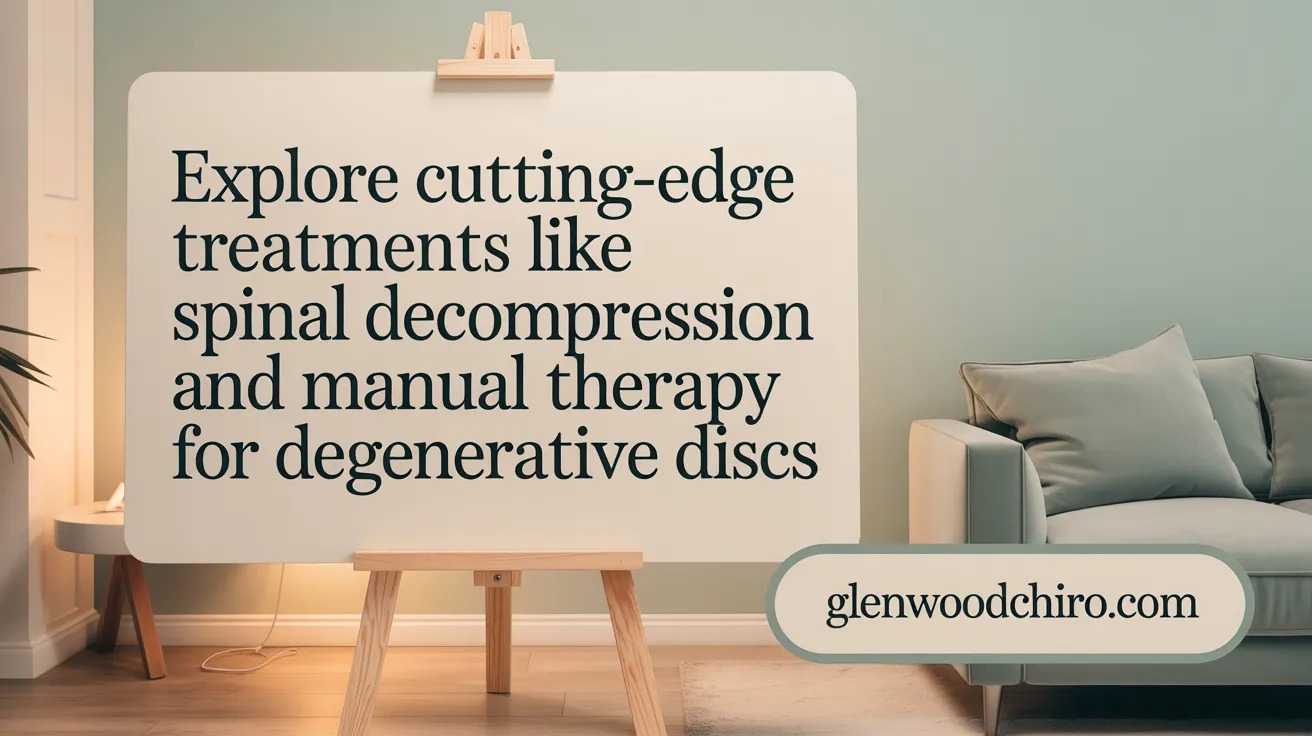Understanding Degenerative Disc Disease and the Need for Non-Surgical Care
Nature and Prevalence of Degenerative Disc Disease (DDD)
Degenerative Disc Disease (DDD) is a natural part of aging, typically starting after age 40. It involves the gradual wear and tear of the spinal discs—the cushions between the vertebrae responsible for shock absorption and flexibility. By age 60, most individuals show some degree of disc degeneration, with the lumbar (lower back) and cervical (neck) spine being the most commonly affected regions.
Common Symptoms and Affected Spinal Regions
Symptoms include intermittent or constant neck and back pain that may radiate to other areas such as the buttocks or arms. Pain often worsens with activities like sitting, bending, or lifting. Reduced mobility, stiffness, and nerve-related symptoms such as numbness or weakness may also occur, especially if nerve compression develops.
Importance of Non-Invasive Treatment Approaches
Non-surgical care is the frontline approach for managing DDD. Treatments focus on pain control, improving spinal function, and promoting natural healing. These include chiropractic adjustments, spinal decompression, physical therapy, and therapeutic exercises. Avoiding surgery reduces risk and supports a holistic recovery process.
Overview of Lifestyle Factors Influencing DDD
Adopting healthy habits is essential in managing DDD. Maintaining a healthy weight, practicing good posture, using ergonomic support, engaging in low-impact activities like swimming and walking, and following an anti-inflammatory diet rich in omega-3 fatty acids help slow progression and alleviate symptoms. Smoking cessation and stress management also contribute positively to spinal health.
Chiropractic Care: Realigning and Rehabilitating the Spine

How does chiropractic treatment help with Degenerative Disc Disease?
Chiropractic care offers a comprehensive, non-invasive treatment approach that targets the underlying mechanical and inflammatory aspects of Degenerative Disc Disease (DDD). By improving joint mechanics and increasing spinal motion, chiropractic treatment can reduce inflammation and help restore disc function, particularly in early-stage DDD.
Chiropractic treatment techniques for DDD
Common chiropractic techniques include spinal adjustments such as spinal thrusting and flexion-distraction, which help realign vertebrae and relieve stress on intervertebral discs. Instrument-assisted manipulation provides gentle, precise corrections suitable for sensitive or advanced cases. Learn more about Chiropractic care for degenerative disc disease.
Spinal adjustments and spinal decompression therapy
Spinal decompression therapy mechanisms gently stretches the spine to create additional space between vertebrae. This process alleviates nerve pressure, promotes disc rehydration, and enhances nutrient flow essential for natural healing and function. See details on Spinal decompression therapy and Spinal decompression therapy.
Manual therapies and electrical stimulation
Additional manual therapies like trigger point therapy and massage release muscle tension around the spine, reducing discomfort and improving mobility. Electrical stimulation techniques, including interferential current and ultrasound, are employed to decrease inflammation, muscle spasms, and pain associated with disc degeneration. Explore Massage therapy and electrical stimulation for disc disease.
Tailoring treatment to disease stage
Chiropractic providers customize treatment plans according to the severity and stage of disc degeneration. Early intervention focuses on restoring movement and reducing inflammation, while care for advanced stages prioritizes pain relief and functional support. Insight on Treatment based on disc degeneration stage and The 4 stages of degenerative disc disease is available.
Benefits and safety of chiropractic care
As a drug-free and surgery-free option, chiropractic care minimizes risks while addressing pain, stiffness, and mobility challenges linked to DDD. This holistic approach, often combined with patient education on posture and lifestyle, encourages long-term spinal health and improved quality of life. Read more about Benefits of chiropractic treatment for Degenerative Disc Disease and Degenerative Disc Disease treatment options.
Physical Therapy and Exercise: Strengthening the Support System

What physical therapy and exercise options are effective for managing DDD symptoms?
Physical therapy is essential in managing degenerative disc disease (DDD) by focusing on strengthening the core muscles that support the spine, improving flexibility, and correcting posture. Targeted exercises such as swimming, walking, yoga, and gentle stretching help reduce the pressure on spinal discs, enhance muscle strength, and maintain proper spinal alignment.
Low-impact aerobic activities improve blood circulation, which promotes disc rehydration and natural healing processes. Additionally, customized physiotherapy exercises for Degenerative Disc Disease treatments can include heat and cold therapy, massage, spinal manipulation, and electrical stimulation to reduce inflammation and alleviate pain.
Together, these approaches strengthen the musculoskeletal support system, enhance spinal motion, and improve overall mobility, which contributes to symptom relief and may slow the progression of disc degeneration. Encouraging patients to engage in regular, controlled exercise also supports long-term spine health and function.
Diet and Lifestyle Modifications: Fighting Inflammation and Supporting Spine Health

How can diet and lifestyle changes aid in easing DDD symptoms?
Diet and lifestyle modifications play a crucial role in managing Degenerative Disc Disease (DDD) by addressing inflammation and supporting overall spinal health.
Anti-inflammatory dietary choices: Incorporating foods rich in omega-3 fatty acids—such as fatty fish, flaxseeds, and walnuts—along with colorful fruits, vegetables, turmeric, ginger, nuts, and olive oil can help reduce chronic inflammation associated with disc degeneration (Lifestyle changes for DDD, Diet to manage inflammation in DDD).
Key nutrients for disc health: Nutrients like lean proteins, healthy fats, and antioxidants support tissue repair and reduce oxidative stress on spinal discs. A nutrient-dense diet promotes disc hydration and cellular health essential for slowing DDD progression (Nutritional support for spinal health, Diet and inflammation in DDD.
Weight management and ergonomic support: Maintaining a healthy body weight reduces excess mechanical pressure on the spine, thereby alleviating pain and preventing further disc damage. Ergonomic adjustments such as maintaining proper posture, using supportive seating, practicing safe lifting techniques, and avoiding prolonged static positions reduce spinal strain (Weight loss to reduce spinal stress, Ergonomic adjustments for spinal health, Proper body mechanics).
The impact of smoking cessation: Smoking impairs blood flow and delays the healing of spinal tissues. Quitting smoking enhances oxygen and nutrient delivery to discs, supporting natural repair mechanisms and reducing symptom severity (Smoking cessation for disc disease recovery).
Daily habits for spinal longevity: Regular low-impact exercises—including walking, swimming, yoga, and core strengthening—enhance flexibility, strengthen spinal muscles, and improve posture. Complementary practices like stretching and mobility work help maintain range of motion and diminish stiffness (Physiotherapy exercises for Degenerative Disc Disease, Core strengthening exercises.
Together, these evidence-based diet and lifestyle strategies form a holistic approach that not only eases symptoms but also supports long-term spinal health in individuals with DDD (Lifestyle modifications for managing DDD, Prevention and Lifestyle Changes for Spine Health).
Alternative Therapies: Acupuncture, Massage, and Beyond

What alternative therapies can help manage Degenerative Disc Disease symptoms?
Alternative therapies play a significant role in managing symptoms of Degenerative Disc Disease (DDD) by addressing pain, muscle tension, and inflammation without invasive procedures.
Benefits of Acupuncture and Massage Therapy
Acupuncture increases local blood flow and stimulates the release of endorphins, the body's natural painkillers, which helps reduce discomfort associated with DDD. Massage therapy targets muscle tension and stiffness, promoting relaxation and enhancing spinal mobility. Both methods are effective non-pharmacologic options to complement conventional care. For more on these approaches, see Alternative therapies for chronic back pain and Chiropractic care for degenerative disc disease including trigger point therapy.
Biofeedback and Electrical Nerve Stimulation
Techniques such as biofeedback help patients gain awareness and control over muscle tension and pain responses. Electrical nerve stimulation methods, including Transcutaneous Electrical Nerve Stimulation (TENS) and interferential current therapy, are used to decrease inflammation, relieve muscle spasms, and reduce pain intensity. Learn more about these therapies at Chiropractic care for degenerative disc disease and Holistic approach for lower back pain.
Complementary Approaches to Pain Relief
Combining these alternative treatments with physical therapy and chiropractic care can optimize symptom management. They help improve muscle function and support overall spinal health, assisting patients in maintaining activity levels and avoiding the risks associated with surgery. For details on combining these approaches, refer to Non-surgical spinal decompression for DDD and Managing degenerative disc disease without surgery.
Integrating Alternative Therapies with Conventional Care
These therapies are most effective when integrated into a holistic treatment plan tailored to the individual's condition stage and lifestyle. Collaboration between chiropractic practitioners, physical therapists, and alternative therapy specialists ensures a comprehensive, patient-centered approach to managing DDD. Additional information on integrated care is available at Degenerative Disc Disease overview and treatments and Chiropractic care benefits for DDD. For information about spinal decompression therapy mechanisms which can be part of comprehensive non-surgical management.
The Future of Non-Surgical Treatments: Regenerative Medicine and Early Intervention
Are there promising new non-surgical treatments for Degenerative Disc Disease?
Emerging research at institutions such as Brigham and Women’s Hospital is advancing regenerative medicine approaches for degenerative disc disease (DDD). These promising therapies focus on using stem cell therapy for intervertebral disc degeneration and gene therapy to restore the critical matrix proteins lost during disc degeneration. By stimulating the body's own disc cells to regenerate and repair, these treatments aim to slow or even reverse the degeneration process, potentially reducing reliance on invasive surgeries.
What is the potential of stem cell and gene therapies?
Stem cell therapies utilize the regenerative capacity of cells derived from patients’ own bone marrow or off-the-shelf sources to replenish damaged disc tissue. Gene therapies seek to modify cell behavior to enhance production of essential disc components like chondroitin sulfate proteoglycan as a carrier in disc therapy. Both approaches are in experimental stages, with ongoing studies optimizing delivery methods and assessing long-term effectiveness and safety before they become widely available clinical options.
Why is early diagnosis and prompt management important?
Early intervention is vital for maintaining muscle strength, spinal flexibility, and alignment. Identifying DDD in its initial stages allows for conservative treatments—such as physical therapy, chiropractic care, and lifestyle modifications—that can slow disease progression and improve quality of life. Timely management helps to preserve function and may delay or prevent the onset of severe symptoms requiring surgical intervention.
What role do clinics specializing in natural, minimally invasive approaches play?
Specialized clinics focusing on non-invasive, holistic care contribute significantly by offering personalized treatment plans integrating spinal manipulation, spinal decompression therapy, nutrition counseling, and physical rehabilitation. Their approach aligns with patient-centered care models emphasizing symptom relief, functional improvement, and sustained spinal health, complementing advances in regenerative medicine as these new therapies evolve.
Natural Pathways to Managing Degenerative Disc Disease
Exploring Non-Invasive Therapies
Managing degenerative disc disease (DDD) effectively often involves non-surgical options such as chiropractic care, physical therapy, and spinal decompression. These treatments focus on reducing inflammation, improving spinal mobility, and promoting natural disc healing. Techniques like targeted spinal adjustments, gentle stretching, and therapeutic exercises support joint function and relieve discomfort while helping to maintain proper spinal alignment.
Embracing a Holistic, Personalized Approach
An individualized treatment plan, incorporating patient history and symptom assessment, optimizes care in DDD management. Chiropractors and therapists integrate manual therapies with lifestyle guidance, including nutritional advice emphasizing anti-inflammatory foods and core strengthening exercises. This comprehensive strategy addresses both symptom relief and root causes, enhancing quality of life.
Early Intervention and Continuous Care
Prompt attention to early symptoms of DDD can stabilize spinal function and slow disease progression. Consistent engagement in physical activity, posture correction, and ergonomic modifications fosters long-term spinal health. Ongoing monitoring and adaptation of treatments ensure responsiveness to changing needs.
Lifestyle Empowerment
Patients are encouraged to adopt healthy habits such as maintaining a balanced weight, quitting smoking, and practicing regular low-impact exercise like swimming or yoga. Such lifestyle choices, alongside safe non-invasive therapies, empower individuals to control symptoms and maintain mobility without surgery, highlighting the value of conservative, patient-centered care.
